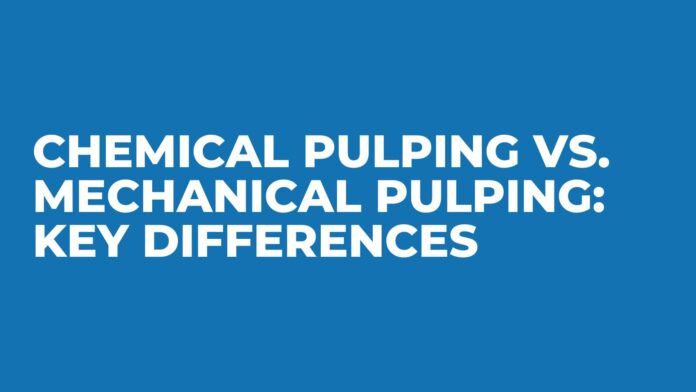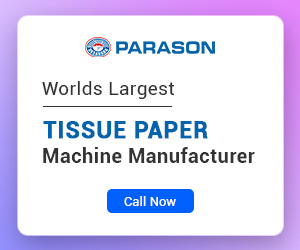Paper is a material used worldwide for various purposes on a daily basis. This includes writing, printing, packaging, and hygiene products. The production of the paper begins with extracting cellulose fibers from wood or other plant sources, and this process is known as pulping.
Pulping is a crucial step in paper manufacturing. It can affect the quality, strength, and cost of the final product. There are mainly two types of pulping, mechanical pulping and chemical pulping. The difference between these two methods is in the process of how they separate cellulose fibers from lignin, the natural binder present in the wood.
In this blog, we will explore the key differences between mechanical and chemical pulping, their benefits and drawbacks, and their respective applications in the paper industry.
Understanding the Pulping Process
Pulping is the process of breaking down wood or other plant materials into a fibrous pulp. It is done to separate cellulose fibers while removing lignin and other impurities that affect paper quality. The raw materials for pulping typically include wood chips, logs, recycled paper, and non-wood fibers like bamboo, hemp, and straw.
What is Chemical Pulping?
Chemical pulping is the pulping process that uses chemical solutions to dissolve lignin, leaving behind cellulose fibers that produce stronger, brighter paper.
Types of Chemical Pulping:
- Kraft (Sulfate) Pulping – This process uses sodium hydroxide and sodium sulfide to remove lignin, producing strong and versatile paper. This method is the most widely used.
- Sulfite Pulping – This type utilizes sulfurous acid and bisulfites to break down lignin. The pulp produced in this type is suited for fine papers but has lower strength than kraft pulp.
- Soda Pulping – Here sodium hydroxide is used for pulping. It results in lower pulp yield but easy bleaching capabilities in the pulp bleaching process. This is suitable for specialty papers.
Advantages of Chemical Pulping:
- Stronger and More Durable Paper – With minimal lignin, fibers remain flexible and resilient.
- Brighter Paper – The removal of lignin enhances the natural brightness of the paper.
- Greater Longevity – Chemically pulped paper resists yellowing and deterioration over time.
Disadvantages of Chemical Pulping:
- Lower Yield – Pulp yield is significantly lower (40-55%) compared to mechanical pulping.
- Higher Costs – Requires more energy and chemicals, increasing production costs.
- Environmental Concerns – Generates chemical waste that requires proper treatment to mitigate pollution.
What is Mechanical Pulping?
In Mechanical Pulping, the wood is physically ground in the wood pulping process to separate fibers while retaining most of the lignin. This process results in high pulp yield but lower paper durability.
Types of Mechanical Pulping:
- Groundwood Pulping – Wood logs are pressed against a grinding stone to produce pulp. This method has a high yield but results in lower paper strength and brightness.
- Thermomechanical Pulping (TMP) – Wood chips are softened using steam before grinding, improving fiber separation and producing stronger pulp than groundwood.
- Chemi-Thermomechanical Pulping (CTMP) – Wood chips are chemically pretreated before mechanical grinding, enhancing fiber flexibility and improving brightness and strength.
Advantages of Mechanical Pulping:
- High Yield – Utilizes nearly all wood components, achieving a yield of 90-95%.
- Cost-Effective – Requires less energy and fewer chemicals than chemical pulping.
- Efficient Energy Use – The process generates heat, which can be reused for energy production.
Disadvantages of Mechanical Pulping:
- Lower Paper Strength – Lignin’s presence makes the fibers stiff, reducing paper durability.
- Limited Brightness – Paper remains darker due to residual lignin.
- Shorter Lifespan – Lignin oxidation causes yellowing and degradation over time.
Comparison: Mechanical vs. Chemical Pulping
| Aspect | Mechanical Pulping | Chemical Pulping |
| Yield | High (90-95%) | Low (40-55%) |
| Cost | Lower | Higher |
| Paper Strength | Lower | Higher |
| Brightness | Lower | Higher |
| Lifespan | Shorter (prone to yellowing) | Longer (resistant to aging) |
| Environmental Impact | Lower chemical pollution | Higher chemical waste |
The above-mentioned comparison may clear your doubts about the pulping process and which pulping is to choose. If you are not sure about your needs and whether to choose mechanical pulping or chemical pulping process for your pulp and paper mill, you can contact us. Our team of experts will guide you according to your requirements and can also get you the best deals for your pulp and paper machinery requirements.
Applications and Use Cases
Each pulping method is suited for different paper products based on strength and brightness requirements.
Common Uses of Mechanical Pulp:
- Newsprint
- Magazines
- Catalogs
- Books
- Tissue paper
- Paperboard
Common Uses of Chemical Pulp:
- Writing and printing paper
- Copy paper
- Envelopes
- Labels
- Fine and specialty paper
Conclusion
Both mechanical and chemical pulping play essential roles in paper production. Mechanical pulping offers a high-yield, cost-effective solution for low-strength paper products like newsprint and magazines, while chemical pulping delivers high-strength, long-lasting paper ideal for writing and fine papers.
Choosing between mechanical and chemical pulping depends on the specific requirements of the final product, balancing factors such as strength, brightness, cost, and sustainability. As technology advances, the industry is moving towards more environmentally friendly solutions, integrating recycled materials and innovative biorefinery approaches to enhance efficiency and reduce environmental impact.
Understanding these processes allows businesses and consumers to make informed decisions about paper production, sustainability, and usage in a rapidly evolving industry. contact us to discuss your requirement and make a wise decision according to your requirements.

